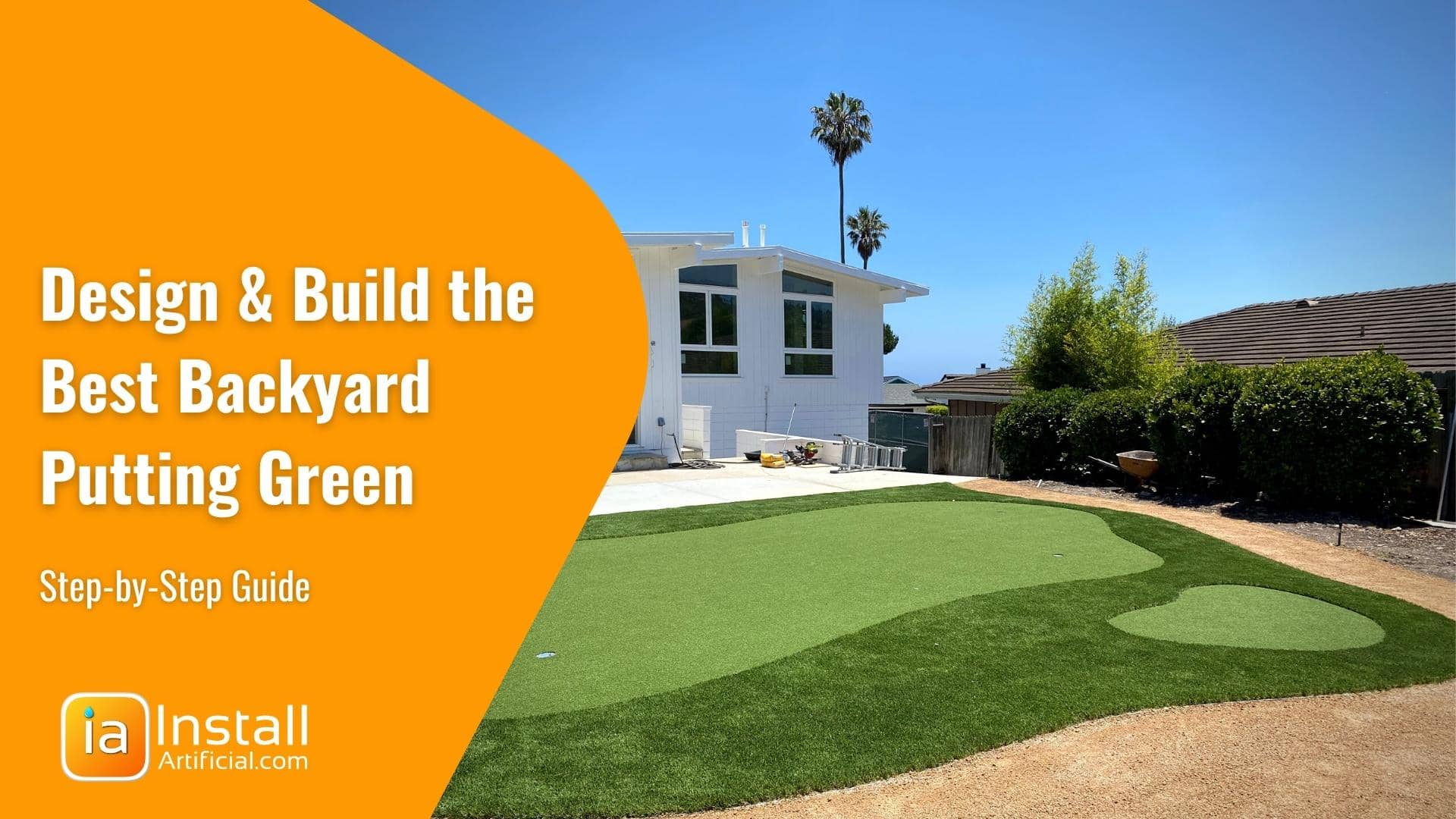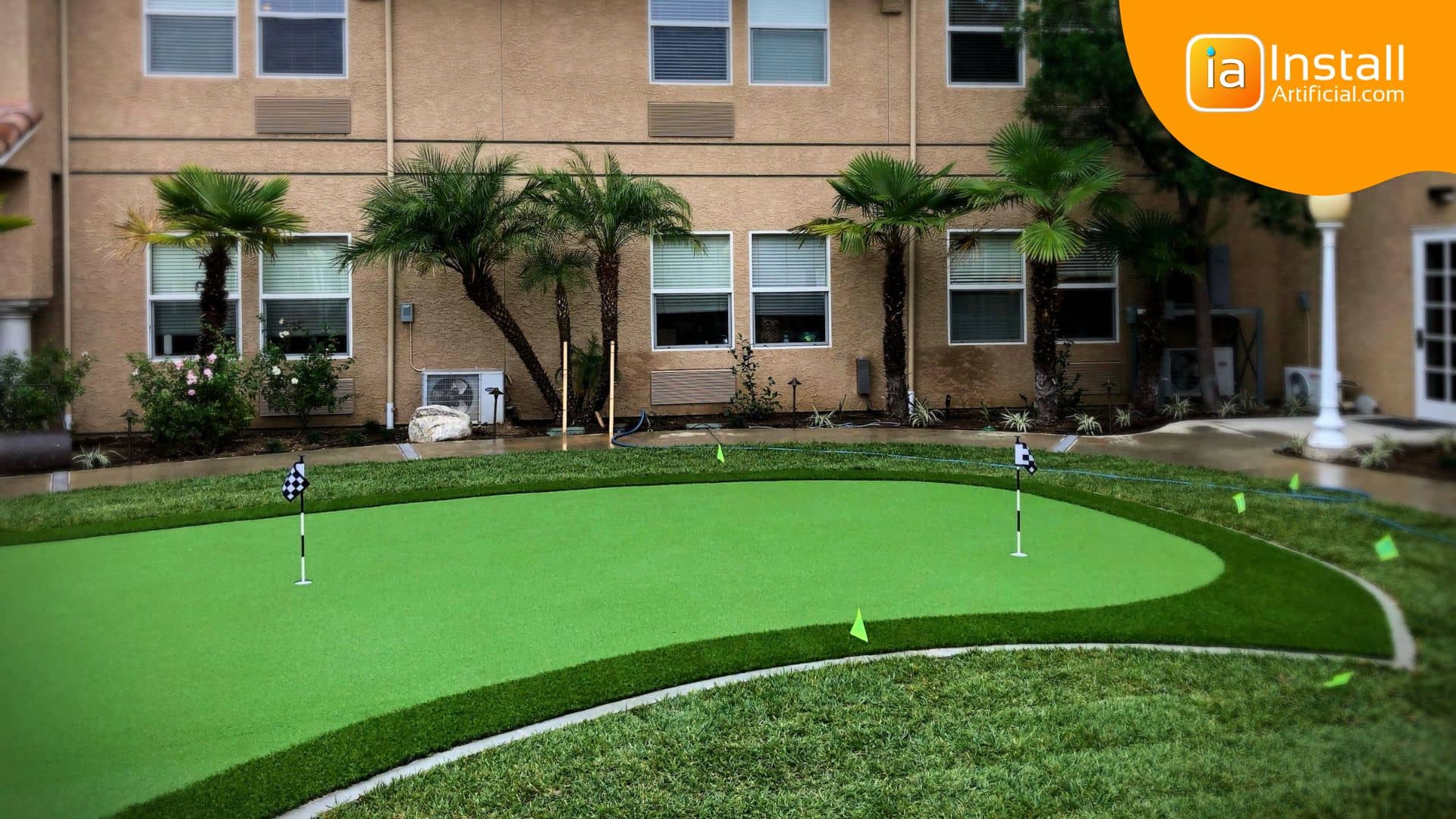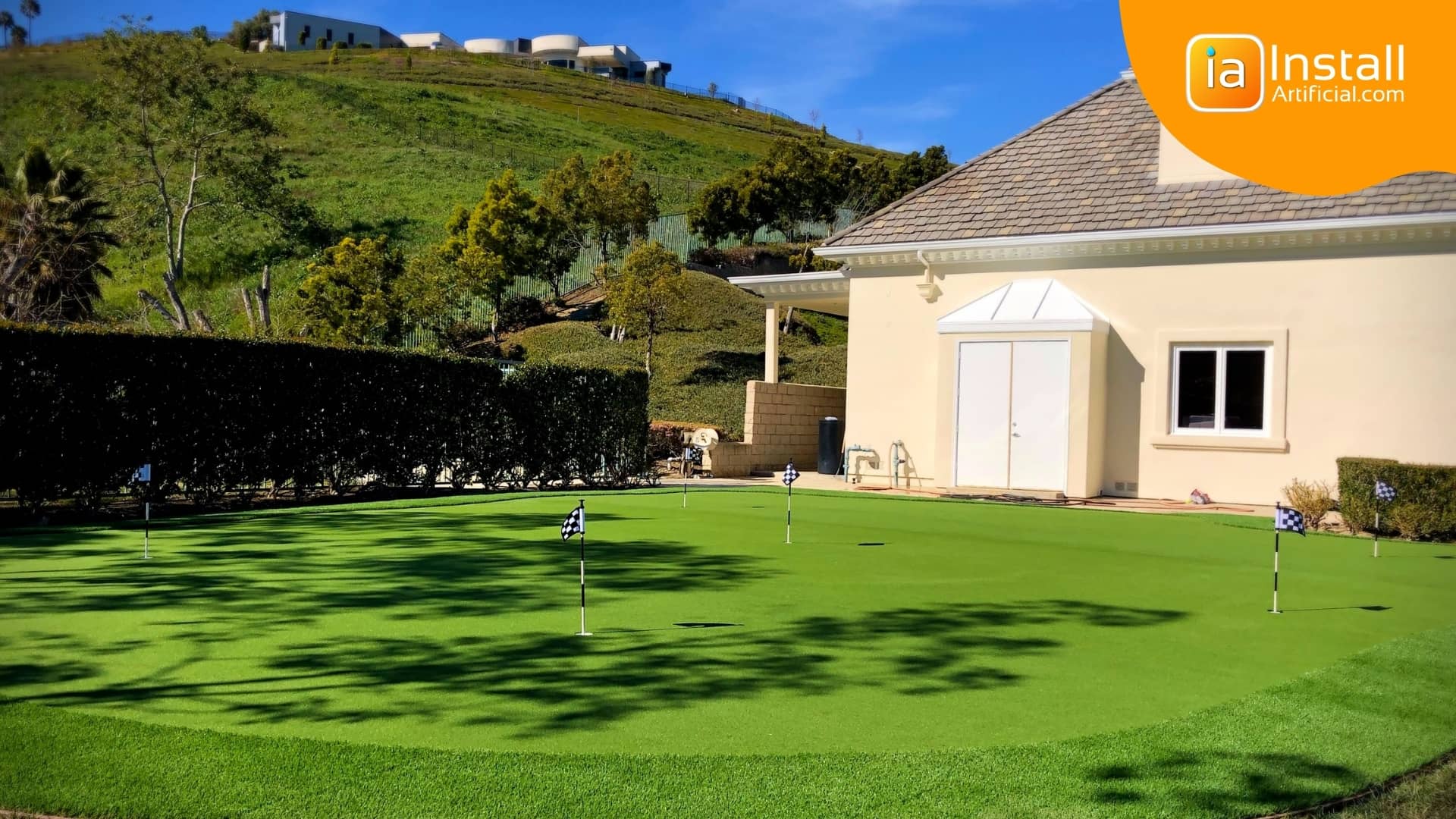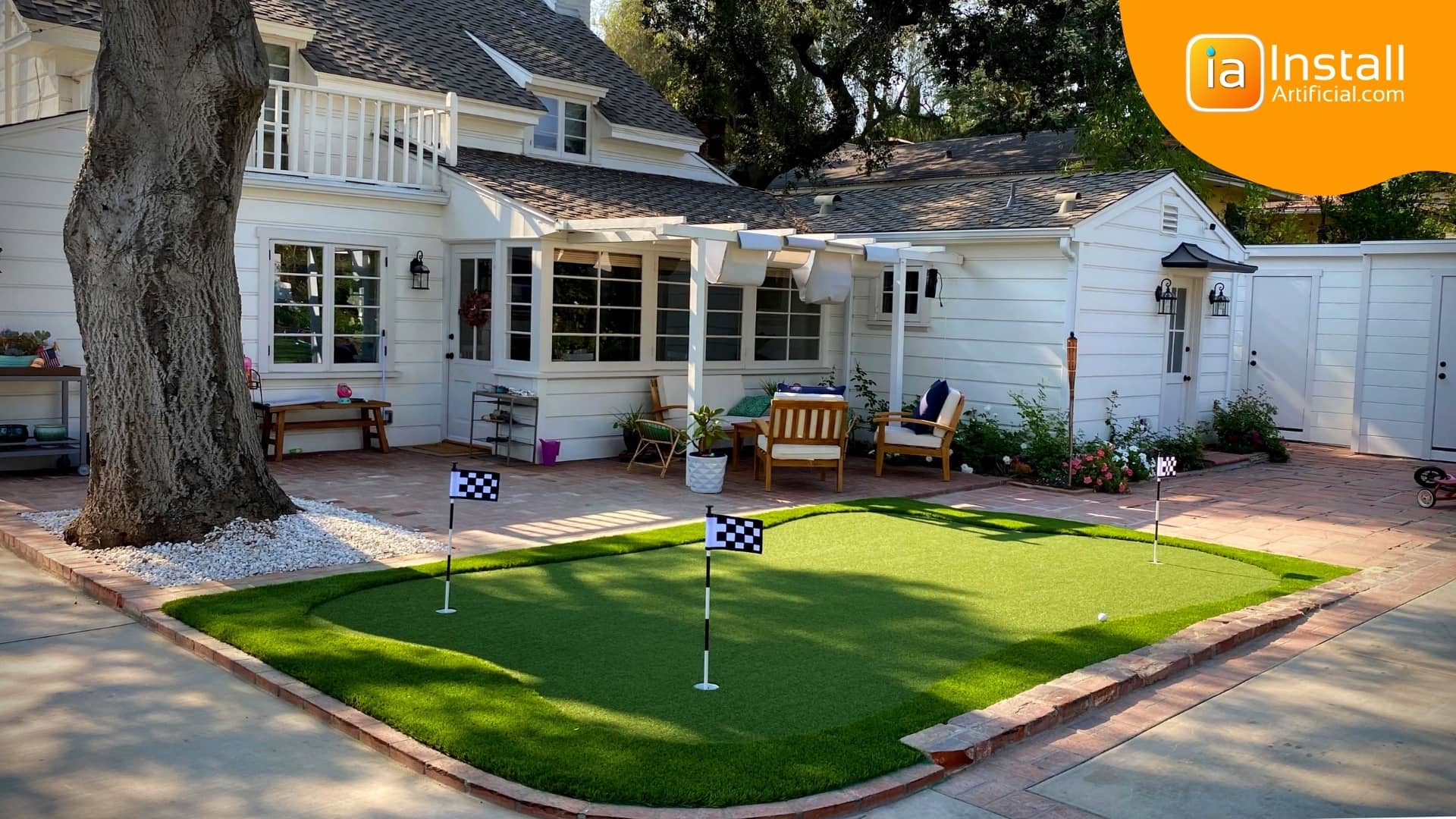
Building, designing, and customizing a synthetic putting green in your backyard can be just as exciting as actually playing on it. Embrace this project and make sure...
What if we told you that the type of plastic used in these materials doesn't necessarily have a significant effect on the overall play surface? Most golfers try to achieve the highest stimp speed of a rolling ball to mimic the most realistic golf course. Let's begin with the physics of a long roll to see how we can achieve this.
What makes the ball roll far? The force of friction is slowing the ball. The lower the force, the longer the ball will roll. Therefore, the rougher the surface, the shorter the distance the ball will roll.
So, for the longest roll, we will need a surface that has just enough grip to make the ball roll, but also with little roughness to help it roll as long as possible.
The stimp rating meter measures the rolling distance but does not reflect a situation when you hit the ball to make it rolling. For example, if your ball is sliding upon the initial impulse, it slows down fast and will begin to roll when the grip is sufficient to make it roll.
This explains why a pro golf player may be confused seeing 11 on a stimp meter but not being able to achieve it with a club. Also, the stimp meter does not show the speed of a golf ball. The speed cannot be measured by linear ft. Yes, there is a correlation between how long the ball rolls and how fast it rolls. However, calling a stimp rating a "stimp speed" meter is incorrect. This alone creates frustrations.
Are you with us on this?
Most articles out there talking about increasing the "stimp speed" by adding more sand are describing old technology and the slit material adjustment process. This has nothing to do with curly surfaces that are used today. The ball does not penetrate curly surfaces at all. Backfilling the curled blades with sand will provide no difference to the stimp speed unless the surface unless you fill the surface with sand all the way to the top.
We haven't even gotten to the materials yet! Let's see how different materials correlate with the physics of a long roll. Below we'll lay out the facts, and share the pros and cons of each material. We'll also share our incites from years of experience in designing and building backyard putting greens, and help you to compare different grasses for putting greens. Now, let's dig into the materials.

This type of putting green features the oldest technology. It generally features a compacted sand infill surface stabilized by plastic blades. The blades are rolled at the top, securing the sand underneath and making the surface hard and smooth.
All the articles mentioning the connection of the "stimp speed" with the amount of sand are related to this old technology. And it makes total sense, the less sand applied, the more blades will stick out, creating friction to slow down the ball.
Polypropylene is essentially just a type of plastic.
Polypropylene putting greens filled with sand are more affordable than other surfaces. This material is preferred for large courses with high maintenance as it will be the most durable for for how cost effective it is. The sand creates a 'beach-like' effect on the slit putting green, where it absorbs the energy of the golf ball, making it stop rolling.
To make this surface feasible to play on today, you'll want to include a soft pad layer so the surface is not so hard. With a soft pad, a slit putting green provides a durable surface with adjustable play.
Customers have complained that the golf ball wiggles around on this surface when putting. This is from not getting the poly fiber to stand up perfectly straight, which compromises the playability of the putting surface. Sand-filled poly greens are also harder to install right away and require more maintenance. Using large amounts of infill can result in sand clumping, blowing around, or even washing off the green.
In recent years, manufacturers have been able to make surfaces with curly fibers that can stand up by themselves mimicking a dense carpet. These surfaces are dense and hold their shape without infill. Poly putting greens also provides a bit of softness. The blades are rolled and curved during production.
The only reason for including sand infill on poly putts is to weigh the material down and provide dimensional stability which will reduce wrinkles when temperature fluctuates.

Poly-putting greens provide a great surface out of the box. They do not require messing with the sand infill levels. Softness and a smooth surface come with this material by default. Poly putting green materials will be comparable in cost to Slit putting green material, but is cheaper than Nylon putting materials.
Poly fibers are not as strong or durable as Nylon or Slit. For this reason, the lifespan of this type of putting green can be shorter. When installing, this turf must be stretched professionally. Otherwise, installers will have to use more infill to prevent wrinkles which can lead to the surface hardening too much. The more infill applied to short poly, the harder the surface gets.
A Nylon putting green is very similar to the look and function of a Poly putting green. Depending on how the fibers are curled, Nylon putting materials can become both smoother and more rough than Poly. It just depends how it was manufactured. However, Nylon is a stiff engineering plastic that provides more durability and melts at a much higher temperature than poly.

Nylon is a very durable and long-lasting material. Nylon putting greens will have a longer lifespan, especially when installed in excessive heat environments, such as rooftops, with the risk of magnification. Nylon putting greens also require very little aftercare or maintenance.
Nylon putting green materials will cost more than poly and slit materials. Game play on Nylon is hard to adjust as the blade memory is stronger than poly or slit.
Comparing slit to poly and nylon putting greens we often hear this question. What is the best putting green material in terms of quality? Quality and composition are two different things. We determine quality by:
For us, the quality of the putting green has nothing to do with the type of material! However, Nylon materials are known to be the most durable so will resist wear and tear for the longest.
We analyzed and researched popular articles and tested different surfaces ourselves. While we can't test thousands of materials, our tests proved to be more in line with our stance in this article: The ball roll will be affected by the texture of the surface, not by the material it's made of.
We did not have the same results as the Synlawn review. During our testing, nylon was not superior to poly in terms of game play. We are not saying their findings are wrong, but they might be comparing materials of a different texture or composition which will naturally differ.
Another article from Coastal Synthetic Turf states that polypropylene putting greens absorb more energy. We're assuming they are referring to slit putting greens, with blades as high as one inch. In our experience, infilled slit poly greens can be hard as a rock. Over time, the sand compacts so well and gets locked with fibers so strong, that the surface acts similar to concrete.
Pro Lawn states that slit polypropylene looks more realistic than nylon. But when we see slit golf fields, many of them look incredibly fake.
Because there are so many differing opinions out there, we see why many golfers get confused with material selection. This is a part of the experience of building your desired backyard putting green. Trust yourself, your intuition, your liking, and trust the power of physics.
To achieve the longest roll, we recommend assessing the surface and texture of the putting green samples. The turf should be firm and smooth, but also coarse. When you touch the putting green material, you should be able to move your hand without the discomforting scratchiness but still feel the grip.
Any material that feels abrasive or rough will cause the ball to slow down quickly. Material that is slick will cause the ball to slide and lose control. You can choose either poly, nylon, or carefully pampered slit. Your choice should not be focused on the type of material. Compare the surface conditions instead.
A slit poly putting green turf is ideal for large areas because with all the sand weighing it down, it is less likely to buckle or wrinkle over time with temperature fluctuations. This is really the only scenario we'd recommend considering a slit poly surface filled with sand, unless you want to spend more time prepping the surface rather than playing on it.
We typically recommend slit surfaces for large commercial putting green golf field projects.
We recommend polypropylene for anyone looking to save a bit more on installation, as it offers similar gameplay to Nylon. However, we are upfront with our clients that poly putting surfaces may not be as long-lasting as Nylon. Yet, many great polypropylene materials provide a great grip and smooth surface out of the box.
A properly selected nylon putting green material provides durability, softness, and golf ball roll performance. Pro golfers typically insist that nylon materials arethe best, and they are in terms of durability. However, we do not think this is critical when installing putting green turf in your backyard. We generally recommend nylon putting green materials for commercial projects with high traffic, rooftop patios, and spaces with the risk of magnification.